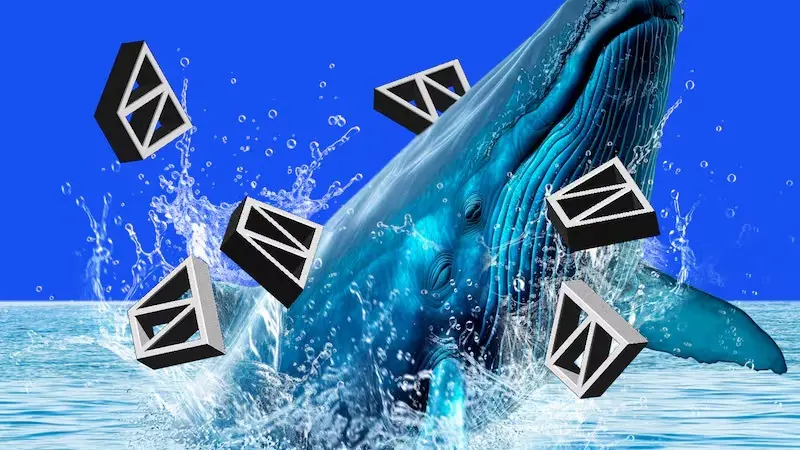In-depth Research Report: Forecasting Market Explosion, Analyzing Leading Players Polymarket and Azuro
Original Title: “The Evolution of Prediction Markets ------ Castle Research Report Deep Dive into Polymarket and Azuro”
*Authors: * Atomist, Mooms, and Francesco, castlecapita
Compiled by: Arain, ChainCatcher
The future is inherently unpredictable. Throughout history, humanity has attempted to forecast it through monetary bets or strategic actions.
Will it rain tomorrow?
Will my enemies attack today?
For a long time, making these predictions has been a matter of life and death.
Historically, most of these markets have been "closed," either centralized or managed by third parties. This means participants must adhere to predefined rules without the ability to create their own markets or set their own conditions.
The emergence of cryptocurrency has provided an opportunity to move these markets on-chain, making them truly decentralized and resistant to manipulation.
Unlike centralized markets, where users trade with a "house," decentralized prediction markets allow users to trade with other users betting in the opposite direction.
Since the launch of Augur in 2015, prediction markets have become a significant use case for cryptocurrency, even mentioned in the Ethereum white paper.
Despite this, they have only recently gained mainstream attention.
Prediction markets have experienced unprecedented growth across all metrics, finding product-market fit (PMF) in speculation around events like the launch of Ethereum ETFs and U.S. election outcomes.
This report aims to provide a comprehensive overview of the prediction market landscape, introducing the concept, highlighting historical use cases, examining current technological levels, and delving into two leading platforms, Azuro and Polymarket, exploring the future potential of this field.
We believe this will be a winner—are you willing to bet?
The Importance of Prediction Markets Between Gambling and Cryptocurrency
Prediction markets are one of the most compelling applications of cryptocurrency, allowing users to place bets on various events on-chain.
Gambling has been rooted in human culture since the Paleolithic era.
By 3000 BC, the Sumerians had already begun using six-sided dice for gambling.
Over thousands of years, humanity has gambled on almost anything.
With the proliferation of technology and the rise of digital natives, gambling has gradually shifted to online platforms, making online gambling a booming industry.
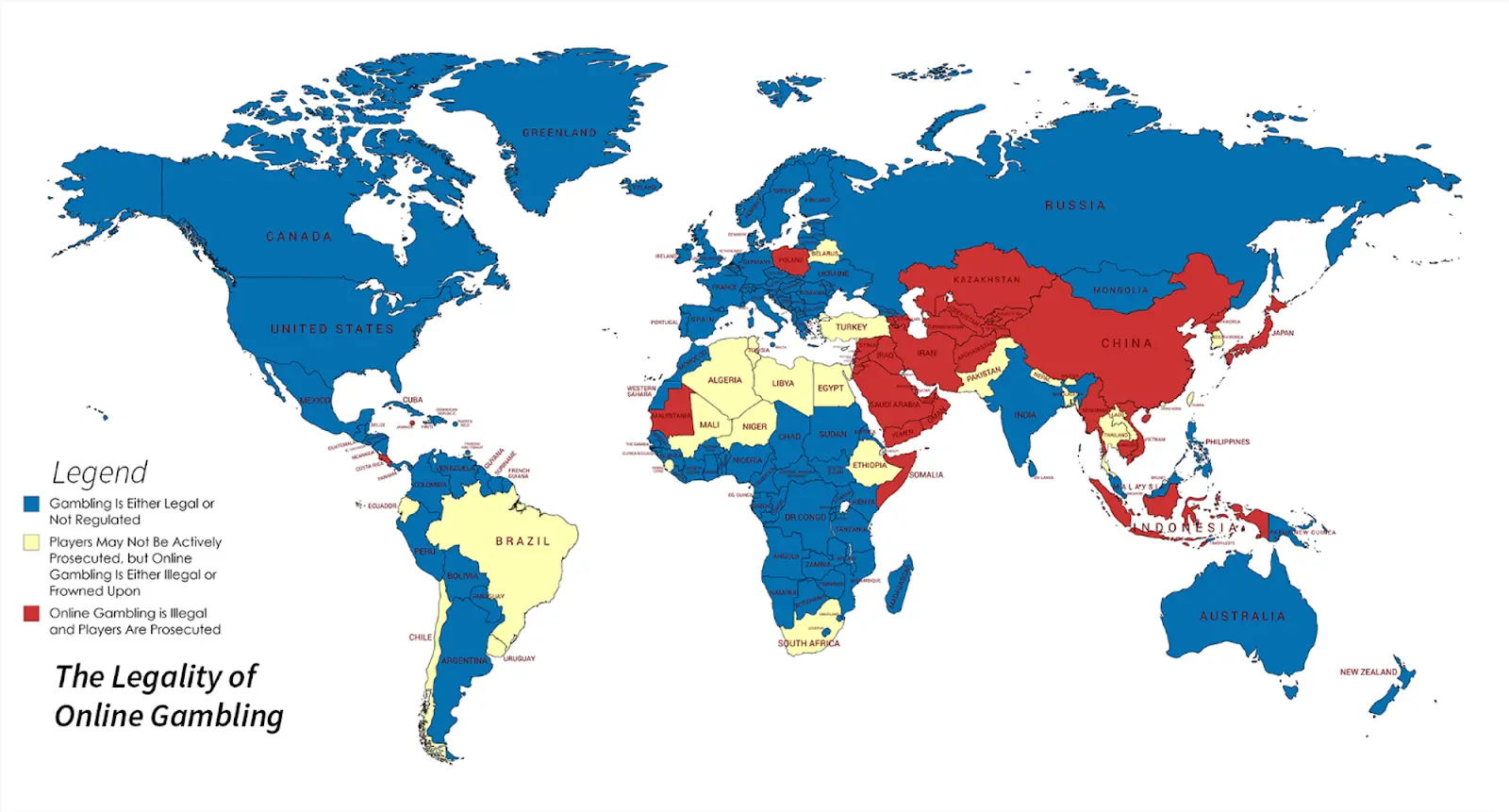
Source: Casinosenligne
The global gambling market is estimated to be $773.7 billion in 2023 and is expected to reach $1 trillion by 2030, with a compound annual growth rate (CAGR) of 3.7% (2023-2030).
Within this broader field, the global online gambling market is projected to reach $100.9 billion in 2024, expected to grow at a CAGR of 6.20%, reaching 281.3 million users by 2029, driven by several significant trends:
Deteriorating global economic conditions
Increase in digital native users
Convenience and accessibility of online gambling
Improved regulatory clarity
The Case for Decentralized Casinos
Nearly one-third of the global population lives in countries where gambling is in a legal gray area or outright banned. Officially, these restrictions aim to protect citizens from the risks of gambling. However, these restrictions do not solve the problem; instead, they drive individuals to unlicensed operators.
As a result, users face worse odds, higher fees, and a significantly increased risk of falling victim to fraudulent or scamming operators.
To fill this gap, global online platform giants like Rollbit and Stake have emerged in just a few years, becoming some of the most popular online gambling platforms, sponsoring influential celebrities, sports events, and teams—and guess what? They all accept cryptocurrency.
In this context, prediction markets have found their place at the intersection of cryptocurrency and gambling, aligning with GCR's proposed "decentralized casino argument."
Compared to other cryptocurrency use cases, prediction markets have less friction because they do not require users to understand all the intricacies of how the system works.
Users are already familiar with online betting, so the transition to prediction markets is seamless, requiring minimal guidance and behavioral change.
About Prediction Markets
Before delving into the importance of prediction markets, it is crucial to introduce the concept. Prediction markets refer to platforms where users can bet on the outcomes of future events.
Their functionality is similar to futures markets but covers a broader range of topics, including not only asset prices but also sports, politics, weather, and even the likelihood of your favorite cryptocurrency influencer going to jail.
Behind the scenes, prediction markets operate through smart contracts that encode the rules of each market, ensuring a fair and transparent system.
Users participate in the market by purchasing shares based on outcomes, valued at 0 (for incorrect predictions) or 100 (for correct predictions).
How Do Prediction Markets Work?
Users interact with decentralized applications (dApps) using stablecoins.
They place bets on the outcomes of events they believe are likely to occur.
Depending on the outcome of the event, they either receive a payout or lose their bet.
Prediction markets can adopt either an order book design (Polymarket) or an automated market maker (AMM) design.
- Prediction markets using an order book (Polymarket) allow users to trade directly with other users, similar to traditional stock or futures markets.
- Prediction markets using an automated market maker (AMM) design (Azuro) automatically match buy and sell orders through smart contracts without human intervention.
In Order Book-Based Prediction Markets:
Users can choose market orders or limit orders.
The liquidity of the market is directly related to user activity and interest.
The order book provides transparency regarding the current bid (Bids) and ask (Asks) prices in each market.
In Automated Market Maker (AMM) Design:
Users are incentivized to provide liquidity to a liquidity pool, forming a "unified betting platform" covering all markets. In exchange, they can earn a portion of the trading fees.
AMMs adjust odds and define prices and other conditions within the prediction engine.
The prediction engine determines all the logic for accepting bets, including payout distributions.
Based on their outcomes, markets can be categorized into various types:
Binary markets: Yes/No (e.g., Will Bitcoin reach $100,000 next month?)
Categorical markets: Multiple options (e.g., Who will be the next U.S. president?)
Scalar markets: Range-based options (e.g., What will Bitcoin's price be next month?)
The History and Early Use Cases of Prediction Markets
Augur Protocol
Prediction markets are not a new concept in the cryptocurrency world.
They are one of the early use cases, with the Augur protocol and its token $REP being among the earliest examples.
Augur is a decentralized prediction market oracle network. Its initial coin offering (ICO) occurred in 2015, with its V1 version launched three years later in 2018.
This anticipation led to a surge in users, making Augur V1 one of the most popular decentralized applications (dApps), surpassing Cryptokitties in popularity.
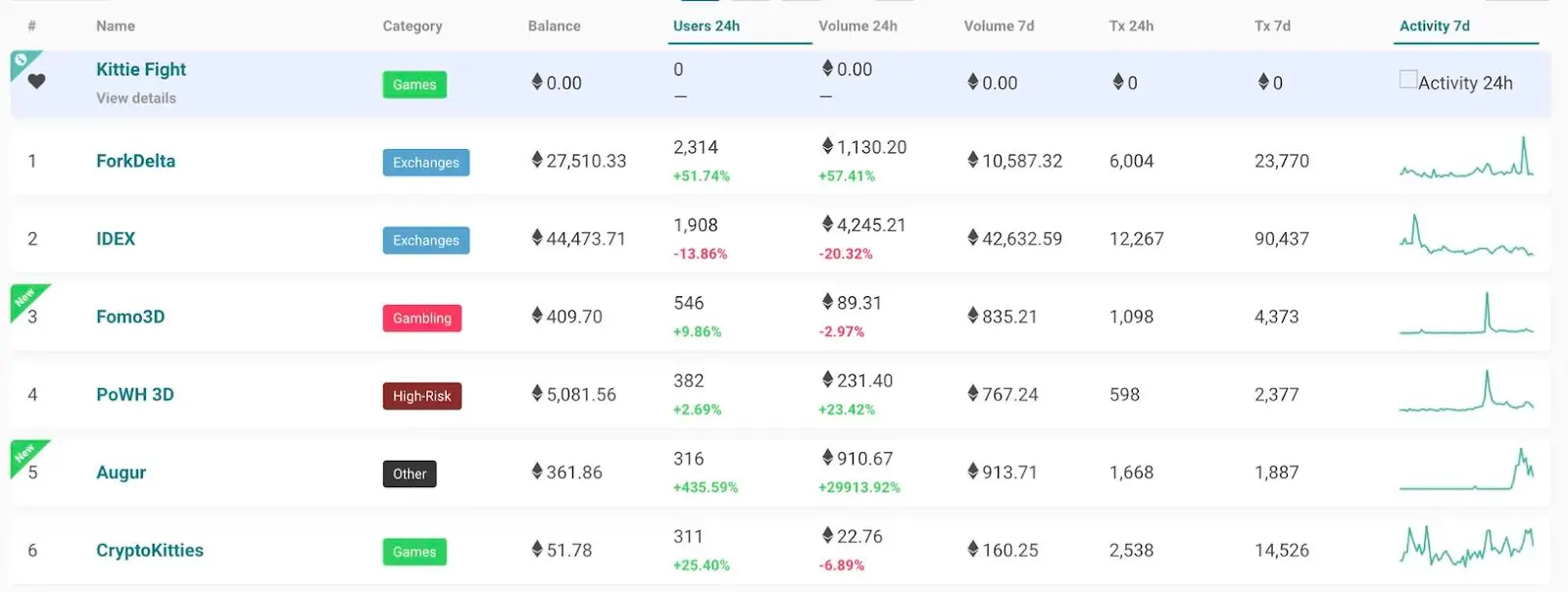
Source: dappradar
Augur's goal was to address a key issue in blockchain: how to transfer real-world data to the blockchain without relying on third parties, known as the "oracle problem." This solution enabled users to bet on controversial markets, including murder.
In 2020, Augur V2 was launched, bringing several improvements:
- Peer-to-peer order book design
- Using DAI as the base currency for trading
These improvements aimed to enhance the system's transparency, efficiency, and user experience. The peer-to-peer order book design allows users to trade directly with each other, while using DAI as the base currency provides more stability and predictability, as DAI is a stablecoin pegged to the U.S. dollar.
Reasons for Augur's Struggles
Despite these improvements to its product, Augur still struggled to gain market recognition, as reflected in the following data.
Historical trading volume:
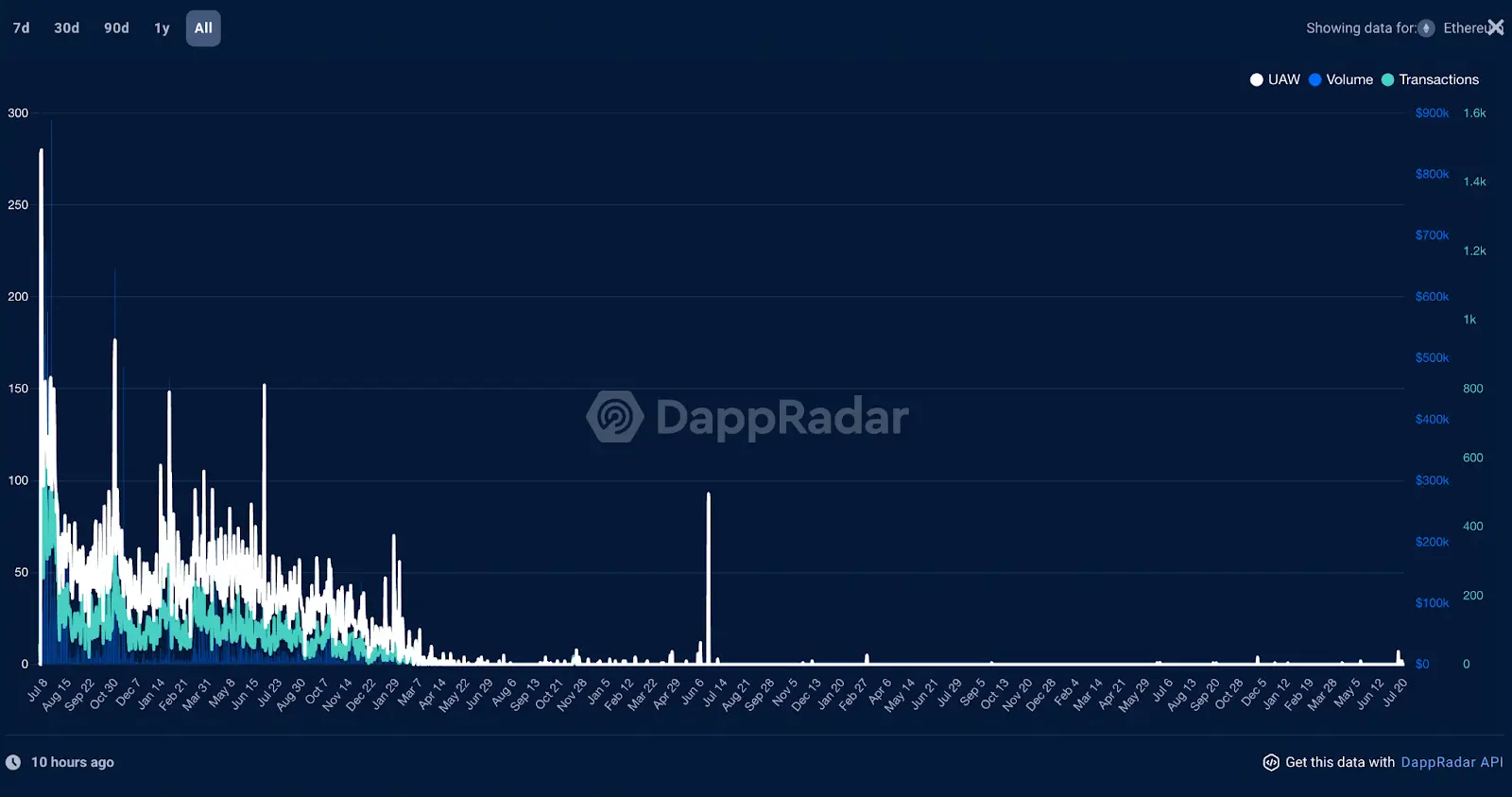
Annual trading volume:
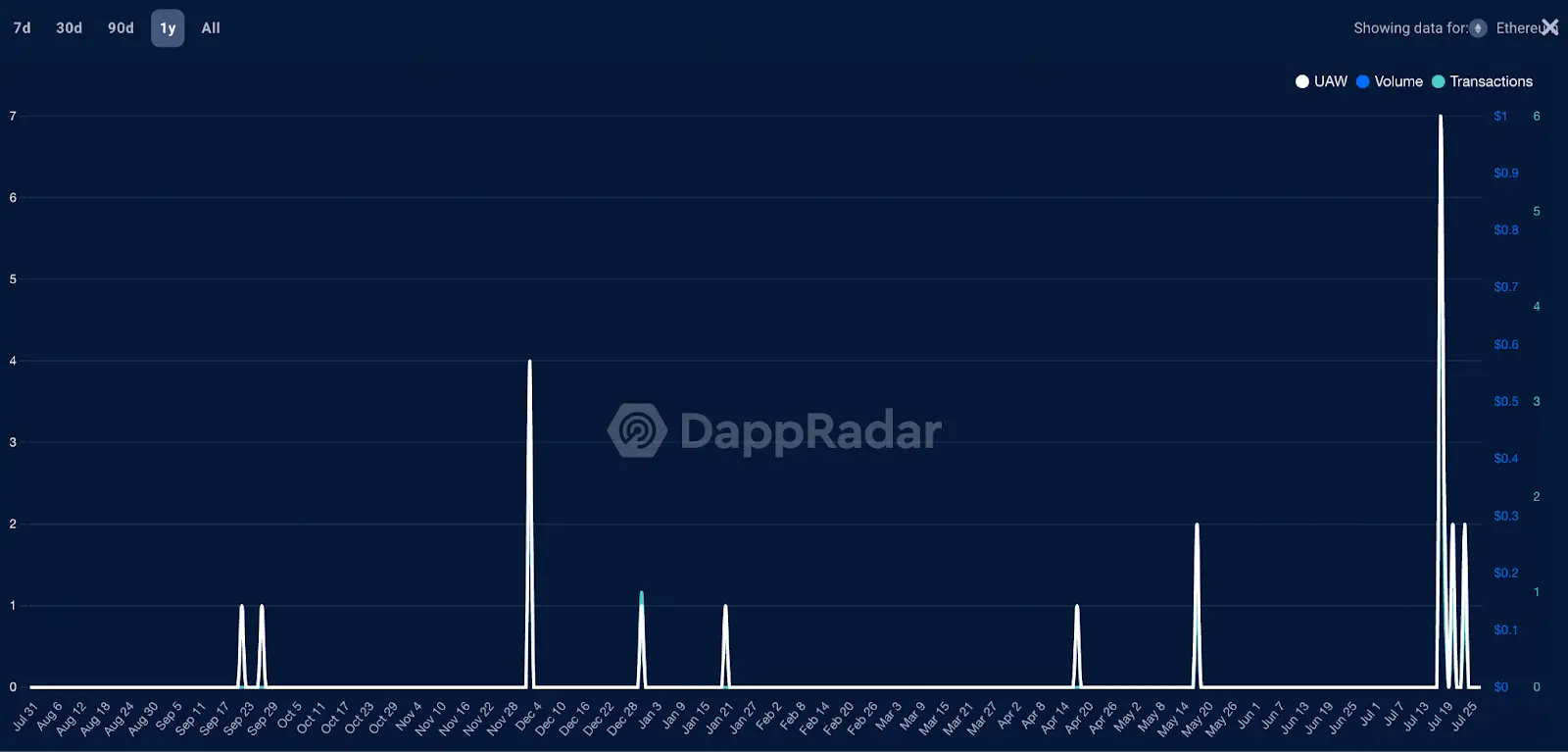
Factors contributing to this outcome include:
- Early entry: When Augur launched, Uniswap V1 had not yet been deployed, and many current liquidity-providing mechanisms did not exist. It was the era of Etherdelta. The prediction markets on that platform also struggled to find a solid product-market fit (PMF), often experiencing a decline in usage after the initial excitement.
- Accessibility: There was no easy way to access the platform. Users had to download the Augur application client and have a well-functioning Metamask wallet with an ETH balance.
- Complexity: The platform's mechanisms and user interface were quite complex, leading to network issues and long connection times.
- Limited number of markets: The limited number of available markets restricted user participation.
- High GAS fees: Built on Ethereum, Augur's transactions were subject to ETH GAS fees.
The Prediction Market Industry
Industry Frontier
Fast forward to 2024, the prediction market industry is experiencing unprecedented interest and growth.
The U.S. elections have become a significant catalyst for the prediction market industry, reflecting the increasingly close ties between cryptocurrency and real-world events (such as ETF approvals and U.S. candidates' political stances on Bitcoin).
Notably, a U.S. presidential candidate mentioned decentralized prediction markets as a source of election data, highlighting the industry's growing relevance.
Prediction markets are now considered one of the most accurate ways to gauge public sentiment on various topics. This increased attention translates into rising trading volumes and growing user interest.
Next, let’s explore the current state of prediction markets through on-chain data and leading platforms, using Azuro and Polymarket as case studies.
Understanding Prediction Markets Through Data
The prediction market industry holds a total value locked (TVL) of $162 million.
While Defillama charts show the industry's situation since its inception, most of the TVL accumulation occurred in 2024.

Source: Defillama
Similarly, trading volume surged from a weekly high of $25 million before June 2024 to $183 million per week in August 2024, an increase of over 7 times.
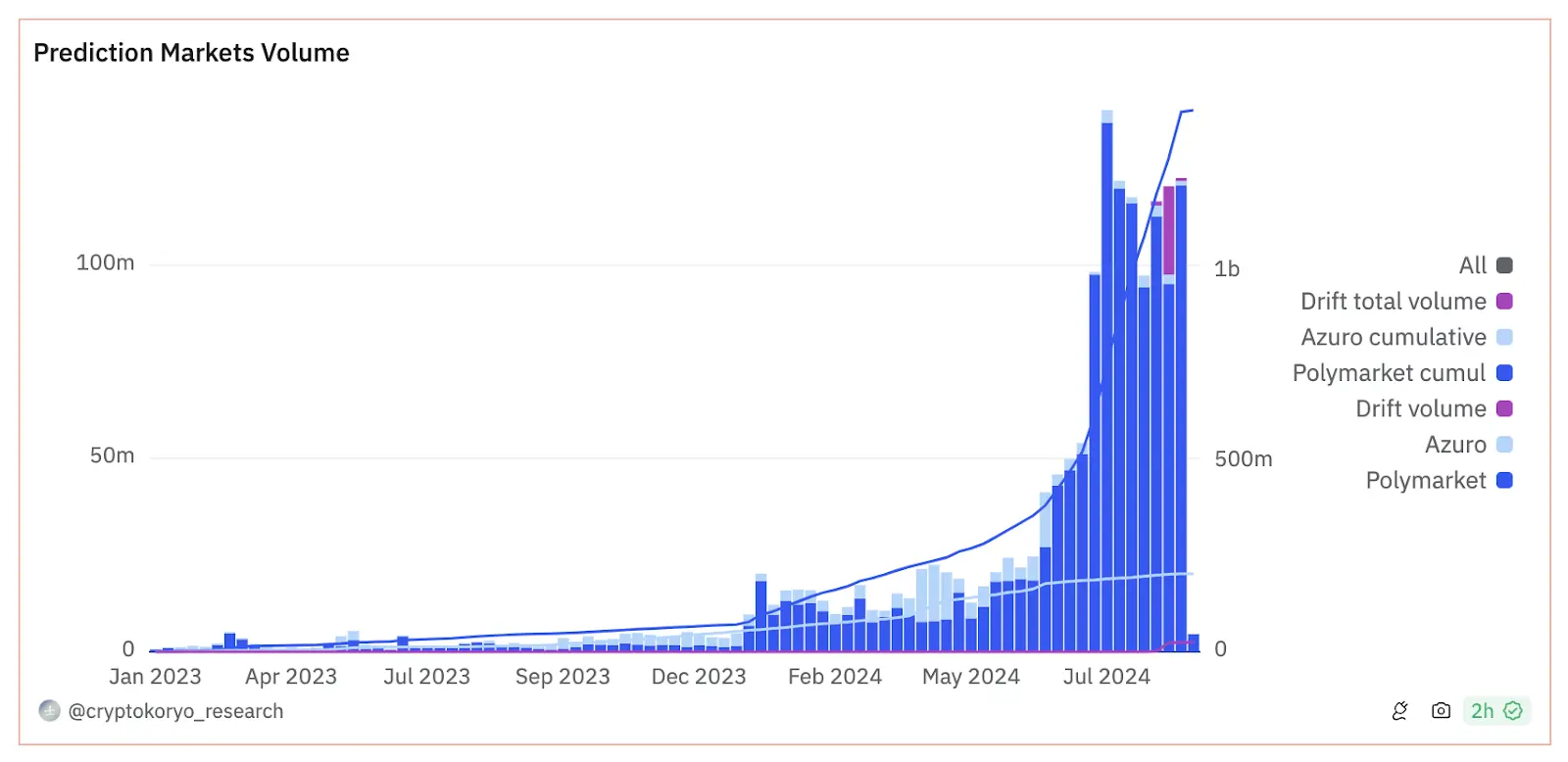
Due to their recent growth, approximately 30,000 users participate in prediction markets daily, a significant increase from the average of 3,000 users before May 2024.
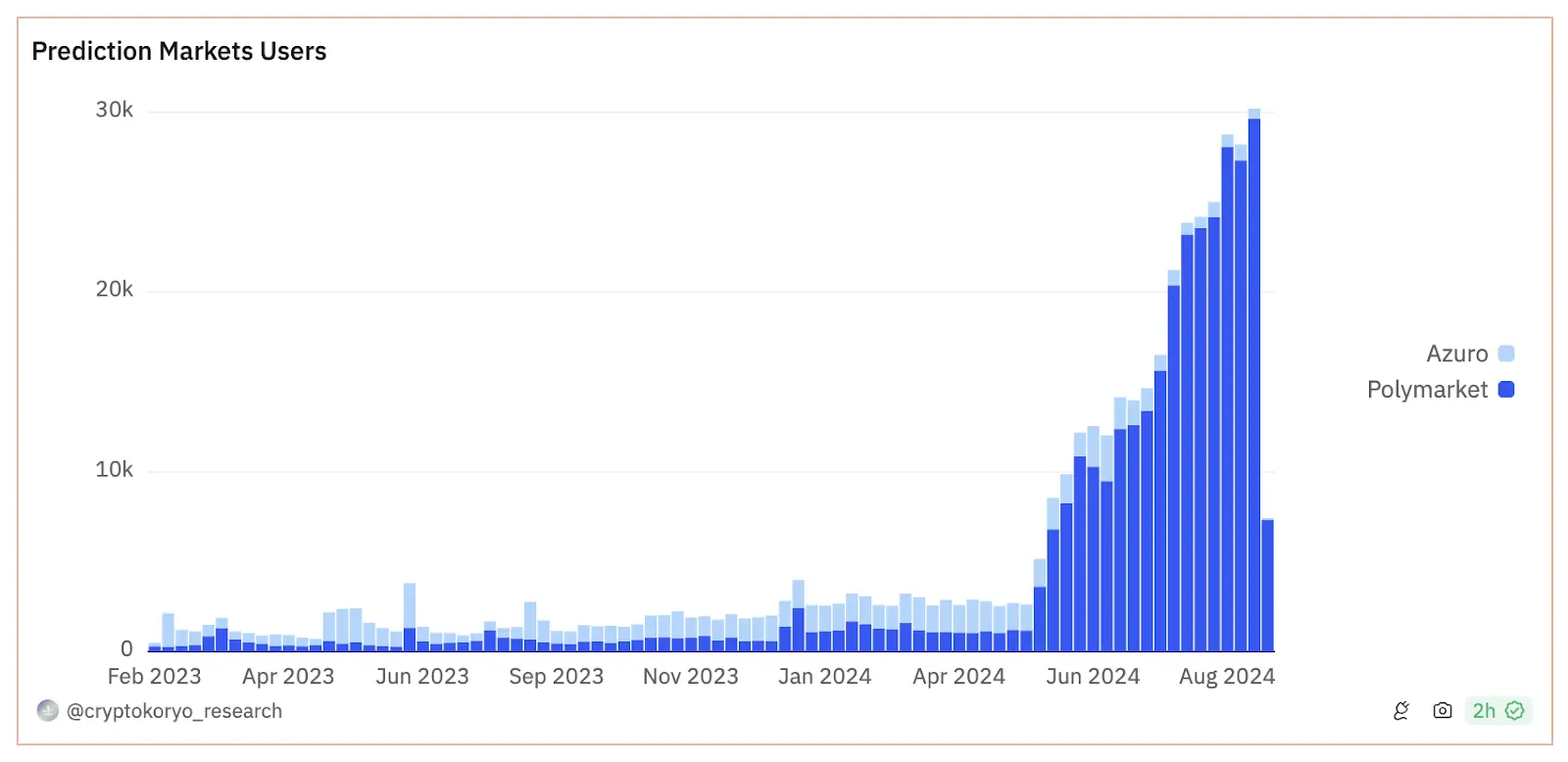
This growth aligns with the rise in daily trading volume, as most of the new trading volume comes from users joining Polymarket to bet on major events like the U.S. elections.
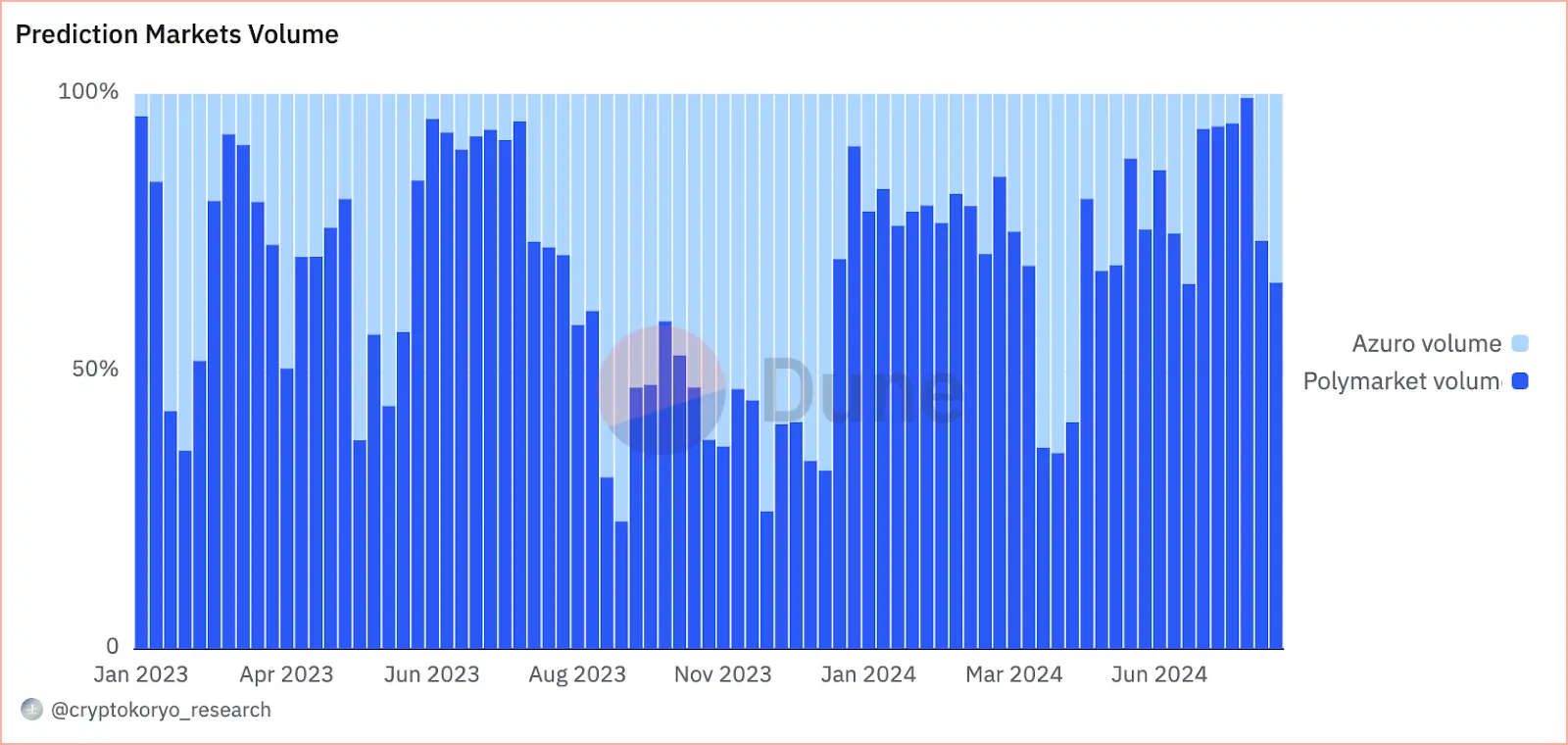
Case Studies of Azuro and Polymarket
This section analyzes two leading players in the industry, Azuro and Polymarket.
It delves into how these platforms work under the hood, their differences and similarities, and argues that these platforms do not compete but complement each other, each with its unique features.
Polymarket
Since its launch in 2020, Polymarket has become a household name in the prediction market industry. Many believe Polymarket is the Trojan horse that will ultimately bring cryptocurrency into the mainstream.
Built on Polygon, Polymarket's TVL (total value locked) has reached $87.5 million, accounting for over 60% of the industry's total TVL.
Polymarket has undergone some evolution during its development. Initially, the market was deployed in the form of a "constant product" automated market maker (AMM), similar to Uniswap V2 pools, where the stock prices of each market reflected the probabilities of outcomes. However, over the past year, the market has gradually shifted to an order book model.
Currently, each market takes the form of an order book, where users can post their bids (Bids) and asks (Asks).
Polymarket utilizes UMA's decentralized optimistic oracle for dispute resolution, with UMA token holders serving as unbiased judges of relevant market outcomes. In cases where there is a disagreement about the outcome of an event, "disputants" can challenge the answer.
Since its inception, Polymarket has achieved the following milestones:
- Over $1.4 billion in trading volume
- 3.1 million transactions
- Over 150,000 total bettors on the platform

As of August 2024, the most popular categories on Polymarket by betting volume are primarily political, with one sports category related to the 2024 European Championship.
Polymarket appears to cater to large-scale, occasional bettors on significant events rather than focusing on frequent small bettors.
The two most popular categories on Polymarket, "Winner of the 2024 Presidential Election" and "2024 Democratic Candidate," contributed over $660 million, accounting for 84.23% of the total trading volume.

As we approach the 2024 U.S. presidential election, it will be interesting to observe whether the cumulative trading volume trends will resemble those of 2020.
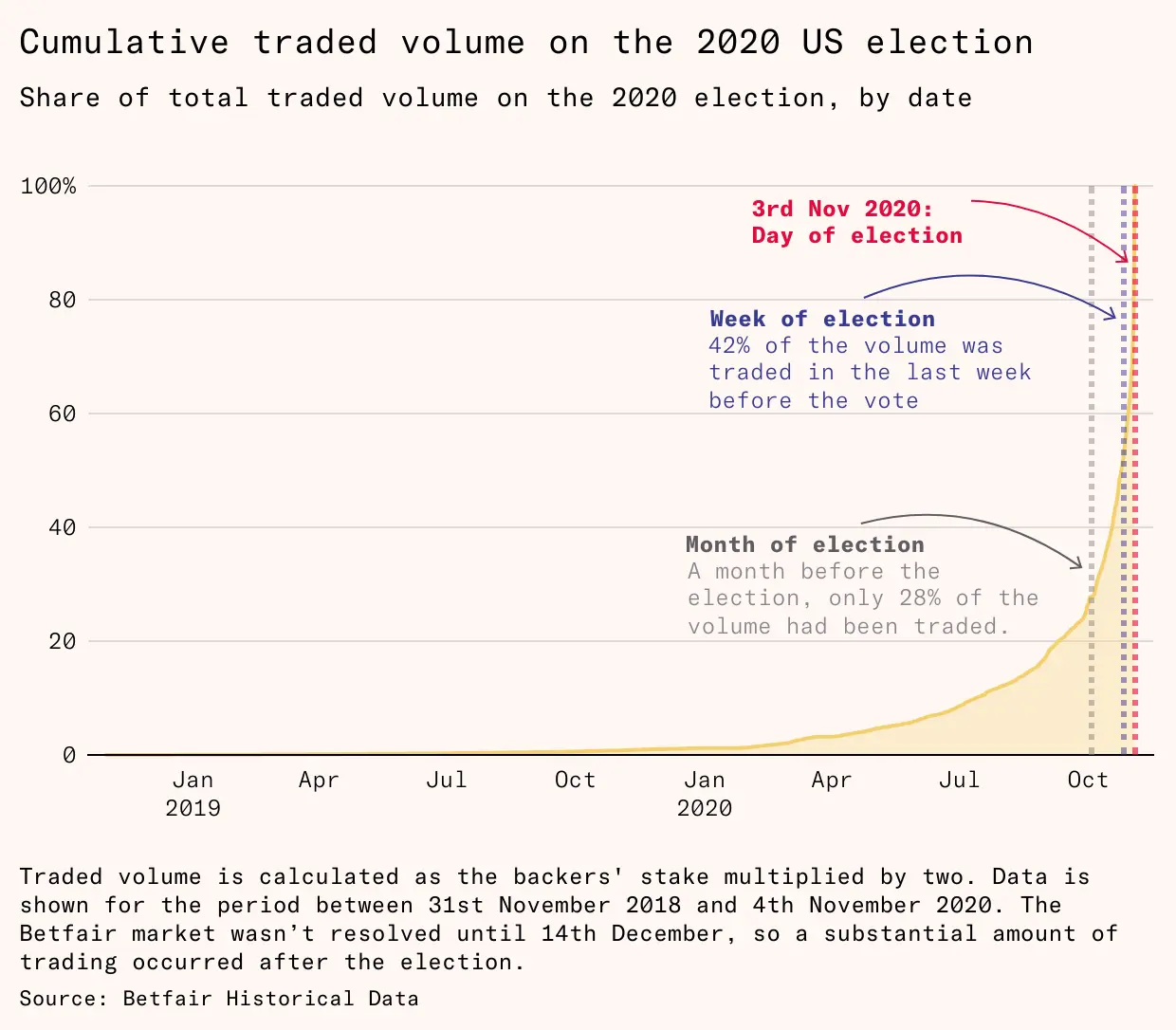
While the surge in Polymarket's trading volume can be attributed to the U.S. elections, all on-chain metrics for the platform have shown positive trends since the launch of Bitcoin ETFs in early 2024, indicating a general increase in the adoption of prediction markets.

As part of its roadmap, Polymarket is committed to increasing the number of supported markets and reducing its reliance on political events.
Recent events, such as the Olympics, have already prompted these markets to become active, with the market predicting the most gold medals at the Paris Olympics becoming the third-largest market, with trading volume exceeding $6 million.
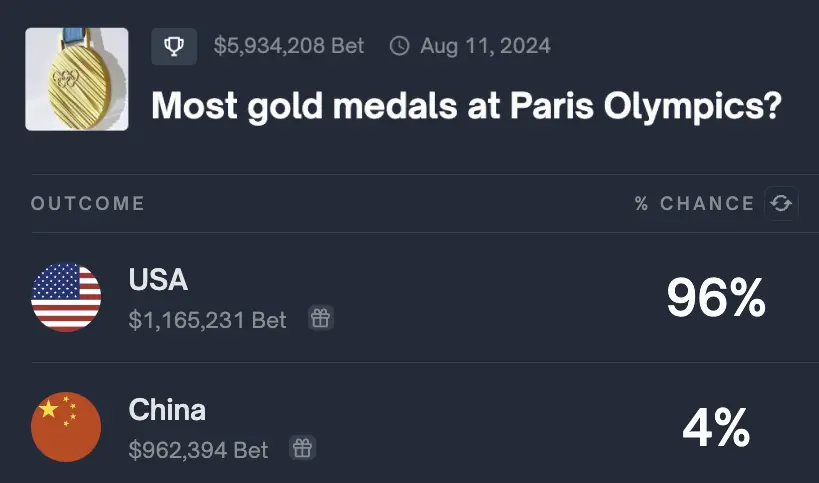
Additionally, they have just open-sourced PolyLend, their peer-to-peer (p2p) lending protocol, which allows users to "borrow USDC using their conditional token positions locked in existing markets as collateral."
PolyLend offers the following features:
- Leverage conditional token positions by borrowing USDC.
- Provide fixed-rate loans in USDC, which are over-collateralized by conditional token positions.
- Transfer loans to new lenders using a Dutch auction mechanism.
Interestingly, Polymarket states that this development will not be used for production but will be open-sourced for the community to build upon.
Azuro
Azuro is an infrastructure and liquidity layer built for gaming dApps and protocols, currently operating on Polygon, Gnosis Chain, and Chiliz.
Azuro introduces a peer-to-peer pool design that addresses the inefficiencies of the peer-to-peer model, including:
- Reliance on active liquidity
- Need for multiple markets to ensure user participation
- Activity concentrated on major events
In this new model, market makers and users interact by providing liquidity in a pool that serves multiple markets. This way, anyone can act as a house and provide liquidity to bettors, creating "passive liquidity" and real yields, with liquidity providers acting as counterparties to bettors on Azuro.
Adding more markets on a single pool also helps diversify the risks for liquidity providers and improves the capital efficiency of the platform, allowing it to scale:
- Support more trading volume
- Enhance user experience
- Increase returns for liquidity providers
This design utilizes a novel data structure called a Liquidity Tree to track the liquidity provided.
Azuro's liquidity pools act as counterparties on the platform, allowing users to provide liquidity and effectively become the house, generating real yields from fees collected by the protocol.
In this way, users providing liquidity to the pool can immediately access all markets supported by that pool and earn fees based on the spreads and trading volumes embedded in the market odds.
Under Azuro, dispute resolution is managed through an "optimistic oracle approach," which they plan to decentralize in the near future. Since Azuro primarily supports sports events, they have clear conclusions, with little involvement in ambiguous situations like political or news-related events. AzuroDAO will serve as the final arbiter of truth in cases of disputes regarding oracle resolution outcomes (to be implemented soon).
In addition to supporting sports markets and more games, Azuro allows anyone to quickly launch prediction applications or websites without incurring any upfront costs, such as bookmaker.xyz, a prediction application.
These frontends can abstract away all core technology, avoid the need for starting liquidity, and directly tap into Azuro's liquidity while earning a share of the profits related to their user activity from the pools, similar to an affiliate marketing model.
Since its launch, Azuro has facilitated:
- Over $200 million in prediction trading volume
- Over 5.8 million prediction-related transactions
- A total of over 30,000 bettors

Azuro's user base has been actively growing, reaching a record high of over 2,500 new users. An interesting observation is that most Azuro users are repeat customers. This indicates that the platform not only attracts new users but also maintains user loyalty and repeat usage rates.
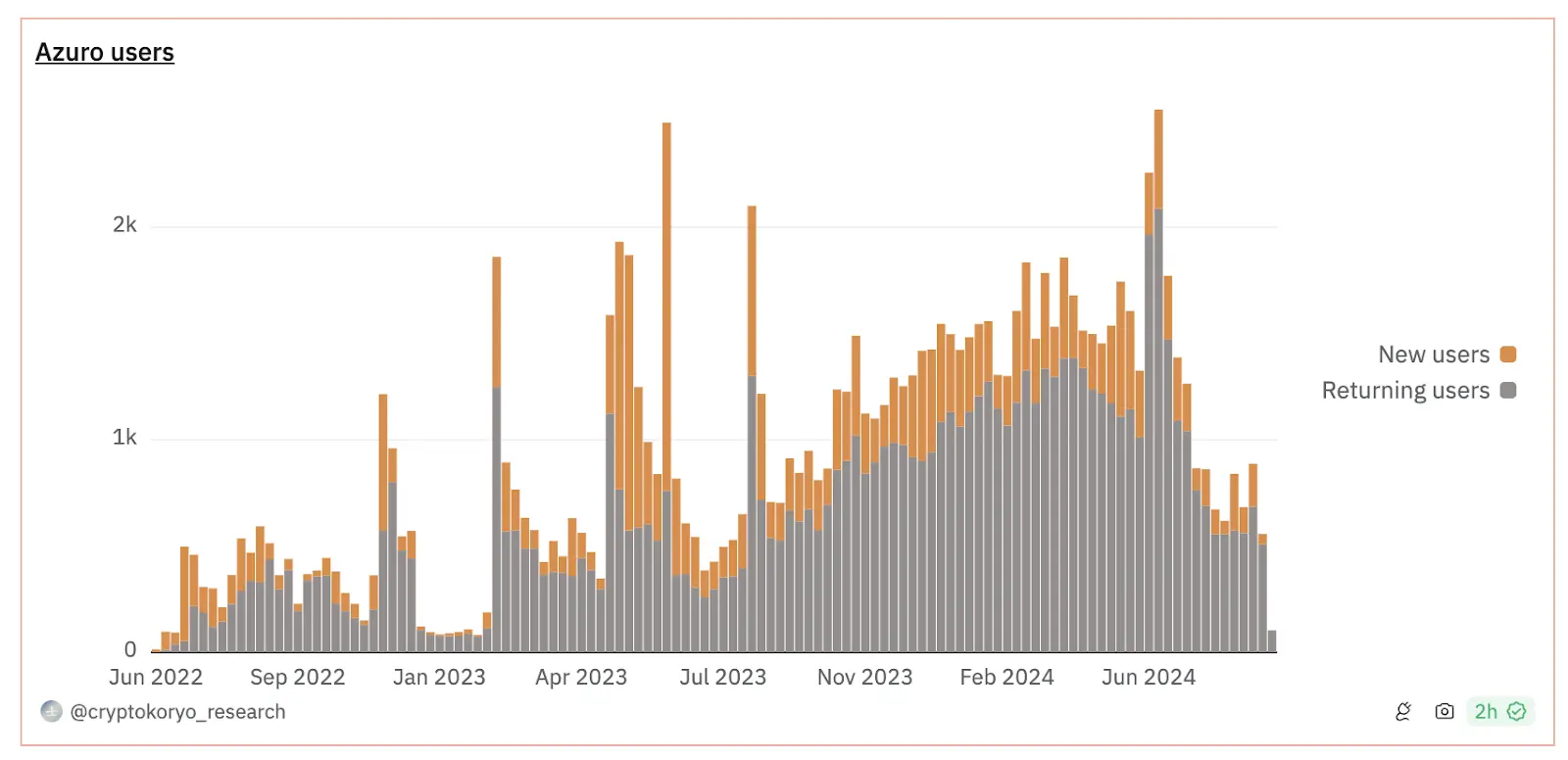
Why is this the case?
The trading volume of Azuro's biggest events only accounts for 0.7% of its total trading volume, so their betting volume is widely distributed. Additionally, they offer a range of events and games to keep users engaged.
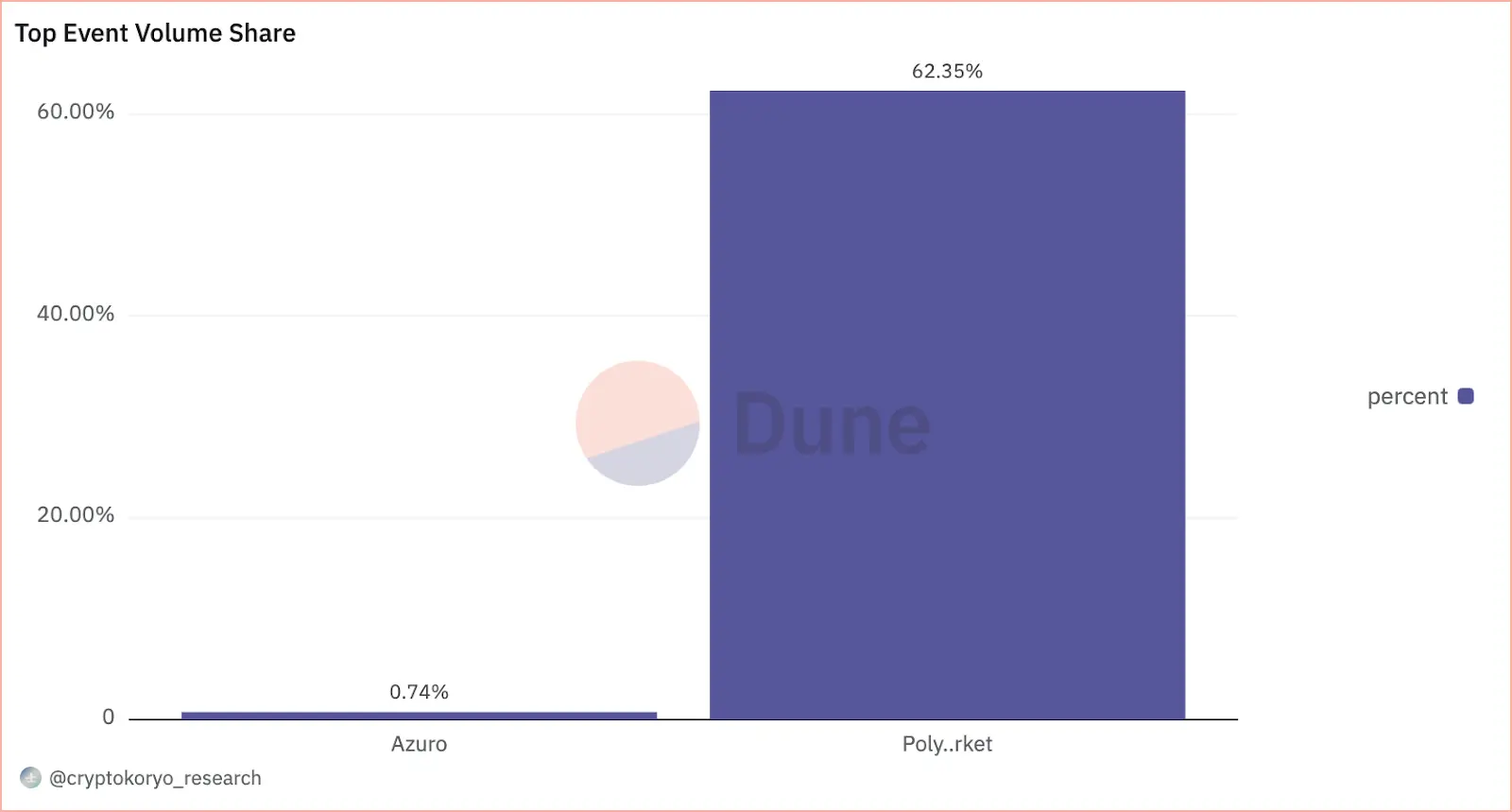
Thus, Azuro primarily attracts users who enjoy making repeat bets across various markets, focusing on sports events.
Let’s take a closer look at which categories drove most of the trading volume on Azuro as of August 2024:
- 58.4% Football events
- 11.9% Basketball
- 11.2% Tennis
- 9.6% Baseball
Among Azuro's top events, the only one not belonging to sports events is esports: Counter-Strike (ranked 6th), League of Legends, Dota 2, and CS:GO.
In these categories, which markets drove the most trading volume?
All of Azuro's top 10 events are football matches. Matches in the Premier League lead in single-match betting volume, with the Arsenal vs. Chelsea match in April 2024 approaching $15 million in betting volume.
As for the number of bettors, international football matches are the most popular.
Since its inception, Azuro has generated over $4 million in revenue for liquidity providers, with an average annual percentage yield (APY) exceeding 20% (currently at 12%).
In Azuro's case, liquidity providers face counterparty risk, as the liquidity pool acts as the counterparty for all trades on the platform and its affiliated platforms.
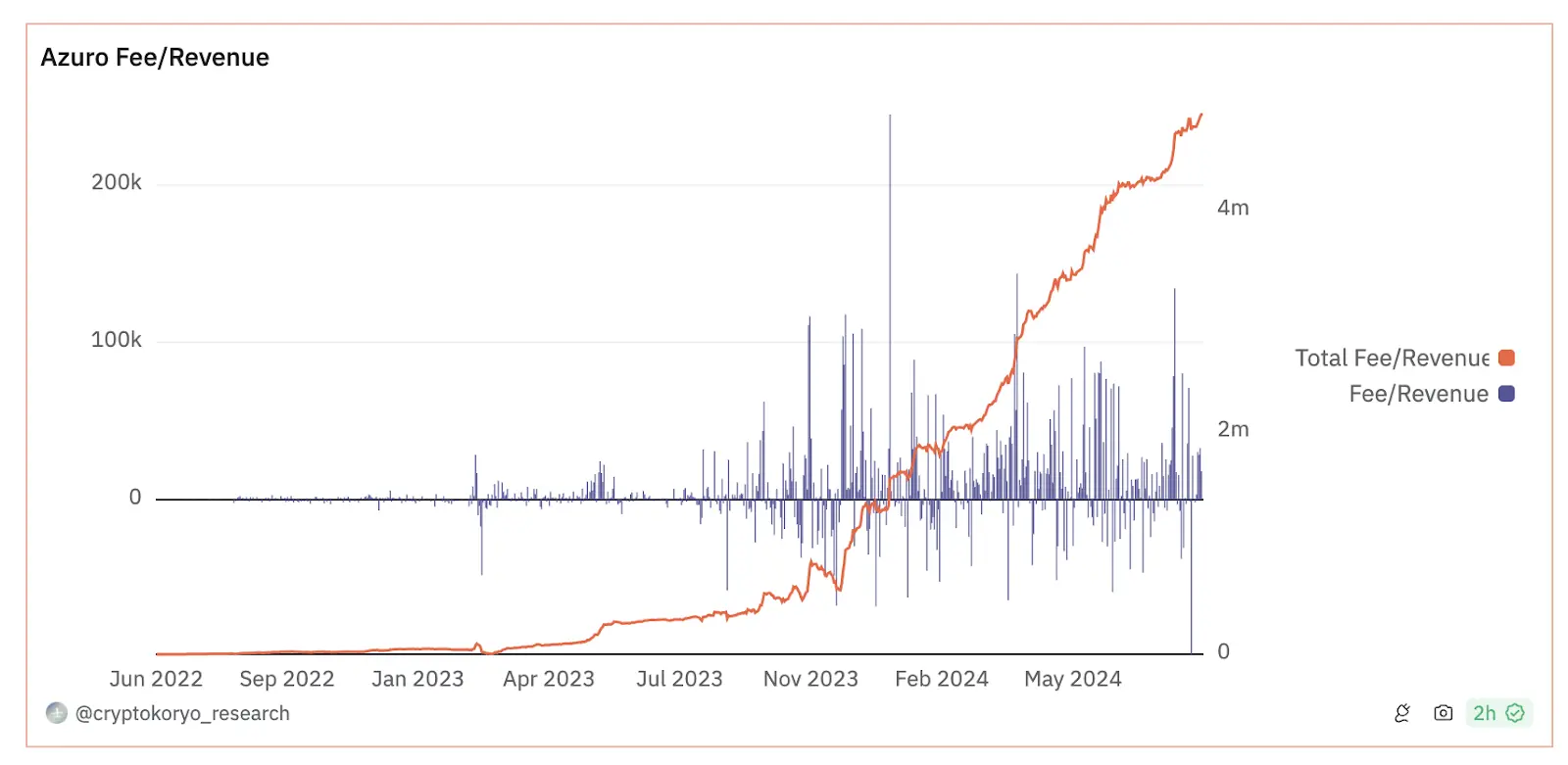
$AZUR Token
Azuro's native token $AZUR is used as a governance token and adds a layer of gamification and incentive alignment between users and the protocol.
Having a native token is one of the main differentiators for Azuro compared to Polymarket.
As part of its roadmap, Azuro is committed to supporting a broader range of events, including social and political events: they recently announced the market for the winner of the U.S. presidential election, which is the first non-sports market for the protocol.
In addition to expanding markets, Azuro is also investing efforts in:
- Decentralizing governance and dispute resolution mechanisms
- Supporting more networks to achieve cross-chain liquidity
- Launching no-code frontends
- Providing further value-added mechanisms for $AZUR and DAO
Comparative Analysis
First, we can see the technical design differences of each prediction market protocol as follows.
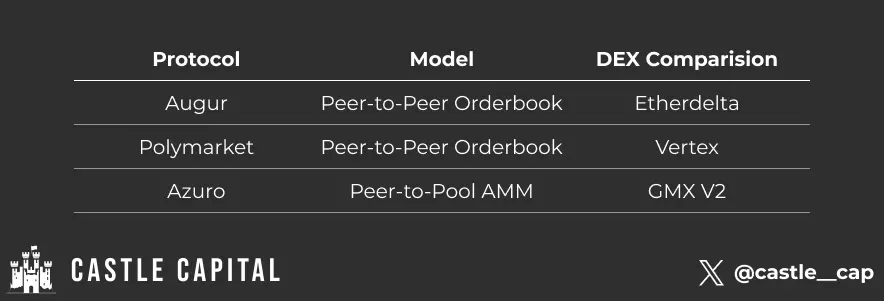
Augur seems ahead of its time, building a traditional order book product on a chain that had not yet scaled or achieved sufficient performance, much like Etherdelta. Polymarket initially leveraged Uniswap's success in the constant product formula for a better user experience, later transitioning to an order book, similar to Verterx. Finally, Azuro implemented a peer-to-peer pool model akin to GMX, allowing Azuro to evenly scale liquidity across all markets with deep pools serving multiple markets, abstracting complexity away from users.
Beyond the technical aspects, we can also conduct a business comparison:
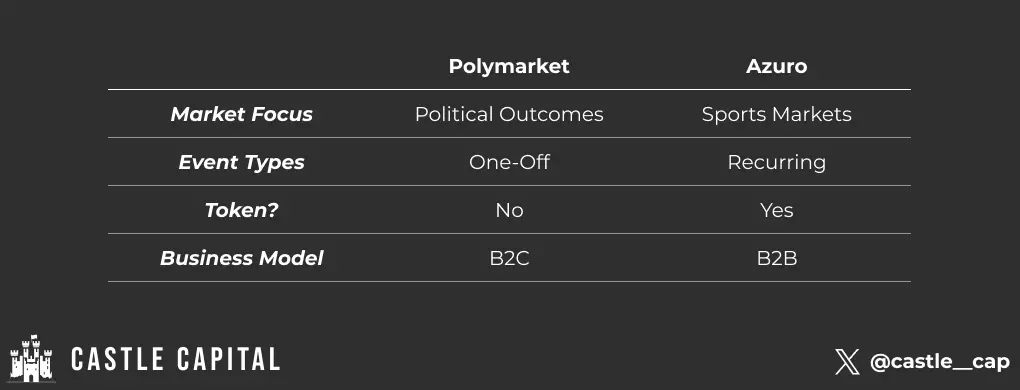
Political Markets vs. Sports Markets:
Before the U.S. election narrative, Azuro became a leader in the field by offering sports-related markets. However, the U.S. elections have become the primary driver of recent success in prediction markets, mainly dominated by Polymarket. Meanwhile, Azuro's reliance on sports events, which have a break during the summer, has led to a slowdown in trading volume during that period.
One-Time Events vs. Repeat Events:
While Polymarket thrives on large but limited markets, attracting strategic narrative speculators who are likely to use Polymarket as a one-time use, Azuro offers many smaller markets that encourage users to return and convert them into repeat customers. On Polymarket, top events account for 62% of total trading volume, while on Azuro, this figure is only 0.74%. This highlights how Polymarket positions itself to capture the largest "news" events, while Azuro's offerings include multiple smaller events, better suited for repeat betting.
Token vs. No Token:
Whether Azuro's token has a significant impact on its trading volume and user growth, having a token provides a broader strategic alignment of incentives between the protocol and the community.
B2B vs. B2C:
These platforms are complementary rather than competitive. Azuro focuses more on B2B and repeat sports events, while Polymarket focuses on B2C and news, political, and economic events.
Seeking Growth:
Both platforms are looking to expand their lists of supported markets and extend to more networks.
Major Challenges Faced
As a novel tool, prediction markets face several challenges before being adopted beyond the cryptocurrency realm:
- Liquidity: Low participation often leads to insufficient market depth, widening bid-ask spreads and reducing prediction accuracy. This low liquidity may also make markets more susceptible to price manipulation by a few participants.
- Regulatory Uncertainty: The legal status of prediction markets varies by jurisdiction, and the lack of clear regulations creates significant legal risks. Compliance with laws such as anti-money laundering (AML) and know your customer (KYC) is particularly complex for decentralized platforms, as these platforms emphasize anonymity.
3. Market Manipulation: The openness and pseudonymous nature of these platforms, along with the relatively small size of certain markets, make them susceptible to manipulation.
4. User Experience: The complexity of decentralized platforms, including the need to manage wallets and understand gas fees, can be a barrier for non-technical users, limiting broader adoption.
5. Oracles and Data Accuracy: Prediction markets rely on oracles to bring external data onto the blockchain. Ensuring the reliability and security of these oracles is crucial, as inaccurate data can lead to erroneous outcomes and loss of trust.
6. Scalability: High transaction costs and slow processing speeds on some blockchains make participation expensive and less appealing, especially during network congestion.
7. Incentives and Governance: Aligning incentives for participants, market makers, and data providers is a challenge. Decentralized governance can be slow and contentious, leading to inefficiencies in managing the platform.
8. Trust and Adoption: Building trust in a decentralized environment without a central authority is difficult. Overcoming these trust issues and convincing users to transition from traditional platforms is key to broader adoption.
Addressing these challenges requires ongoing innovation, regulatory engagement, and community development to ensure the long-term success of decentralized prediction markets.
The Future of the Prediction Market Industry
In prediction markets, people vote with their money.
As such, they are increasingly recognized as capable of providing accurate public sentiment on various topics.
Platforms like Azuro and Polymarket lead this field, each with its unique strengths and market demands. Azuro excels in sports markets and repeat events, while Polymarket dominates significant political and news-related events.
As a short-term goal, both platforms aim to expand their market offerings.
Polymarket seeks to reduce its reliance on U.S. elections, while Azuro aims to support more political and news markets and drive more trading volume beyond sports betting.
The future of prediction markets looks promising, with immense potential for AI integration and market product expansion, enhancing their utility and appeal.
One speculation involves AI agents, predicting that markets will shift from manual market creation to AI-led initiatives. For instance, Azuro plans to develop intelligent AI agents using Olas that can perform specific tasks on its platform. In prediction markets, we can envision AI agents efficiently providing liquidity to markets and extracting API data from them.
Moreover, they will assume the role of "guardians" of the system, resolving conflicts and preventing disputes, enhancing the resilience and smooth operation of prediction markets.
As the industry evolves, prediction markets are poised to become key tools for measuring public sentiment and making informed decisions in a decentralized manner.
In this way, using prediction markets could lead to genuinely decentralized sentiment, which could be natively integrated into news websites and mainstream newspapers, even utilized by politicians.
Prediction markets like Azuro and Polymarket may further solidify their positions in "real sentiment," providing API services for news and data providers.
Indeed, prediction markets are not limited to cryptocurrency users; they also offer an intriguing avenue for traditional gamblers, political experts, news publications, and others.
This may also slightly alter the platforms, expanding into decentralized surveys and other forms of polling to gauge public opinion, build arguments, and test hypotheses and assumptions.
"As news noise continues to rise, prediction markets represent an 'economically supported source of real information' in a world increasingly plagued by fake news, post-truth, and deepfake issues."
Prediction markets ultimately break the mainstream narrative.
Will they maintain their positioning beyond seasonal hype?
Can we expect more challengers to enter this market once it solidifies?
It’s worth pondering.











